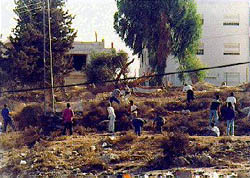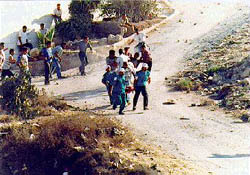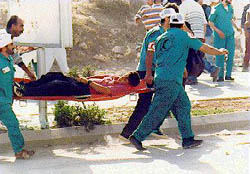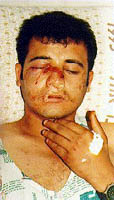
Left: When you see how close to the house the demonstrators would go to throw stones, you get a pretty good idea of why there were casualties.
Note the kid standing in the left of the picture, just to the right of the pylon in the purple shirt. He is about to get injured. Photo by Nigel Parry

Right: After being hit by a rubber bullet in the right pelvis area (believe me it would hurt from that close), the kid is stretchered away by an ambulance crew. Photo by Nigel Parry
Naturally, ambulance crews were occasionally hit by Israeli fire of one kind of another. One friend reporting seeing an ambulance that had had windows shot out.
Another, who was hit by 'rubber' bullets, reported that the ambulance crew that were carrying the stretcher were hit when they were carrying him. A bunch of demonstrators picked up the stretcher and carried on with it but were also hit. Eventually, somehow, he was got to an ambulance.

Left: Still crouched round the side of the wall, I snapped this last photo of the boy, clearly around 15 or 16 years old. Photo by Nigel Parry
You wondered how come so many children were injured during the Intifada? This is how.
UNWRA, the United Nations Relief and Works Agency, recorded 22,000 injuries to children from December 1987 to mid-1996 in Gaza alone. Clubs, beatings, rubber bullets, live ammunition, teargas, etc.,.
Anyway, this kid was lucky. Not so Ahmed, a Birzeit student wounded on the first day, pictured below.

Right: Ahmed was shot from within 20 yards in the face with a "rubber" bullet, on the first day of the troubles. Photo by Kifah al-Fani
It damaged his sinuses and, we thought, possibly his eye, leaving him in incredible pain. So much for the "rubber" part of the 1cm diameter steel ball. I visited him a couple of days later and the worst of this seemed to be over. He later made a full recovery.
When I asked Palestinian Colonel Khalid Diab why the police, standing 30 yards away from the demonstrators, were not stopping them, he told me, "All day, we have asked the Israelis to stop firing so we can go in and remove them. They have not done this and continue to provoke the people. If I send my men in without a ceasefire and one gets injured, I will not be able to stop them from opening fire and the whole situation will escalate again. Because of this, the people are justified in throwing stones."
"The promises made to them in the peace process," he added with a look that questioned me in return, "have not been fulfilled."